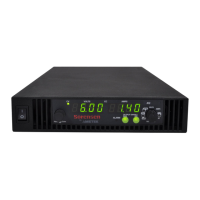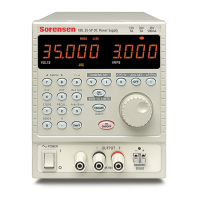Calibration and Troubleshooting
7-6 M370430-01 Rev B
Calibrating the Output Voltage
Gain calibration of the power supply has the greatest effect on the
accuracy in the high voltage range. Offset calibration has the greatest
affect on accuracy of the power supply at low voltages. The same
calibration command is used for the gain and offset calibrations. The
type of calibration is determined internally by the instrument depending
on if the set point is above 10% of the maximum output voltage value or
not. If it is above 10% of the maximum voltage, the calibration is a gain
calibration; if is below 10%, it is an offset calibration.
Gain Calibration
To perform gain calibration:
1. Disconnect the power supply from the load.
2. Connect the output terminals to a precision voltmeter.
3. Turn both the power supply and the voltmeter to On.
4. Set the current set point to maximum. Set the supply output to
90% of the nominal voltage level.
5. Turn on the output power.
6. Read the voltage value on voltmeter display.
7. Type the SCPI command with voltage value as parameter
“data”.
For example, type :CAL:OUTP 138.3 if you had an XG (or XTR)
150-5.6 calibrating with the voltage set point set to 135 V and the
voltmeter was reading 138.3 volts.
Offset Calibration
To perform offset calibration:
1. After performing gain calibration, set the programmed
voltage 10% from nominal.
2. Read the voltage value on the voltmeter display.
3. Type the SCPI command with voltage value as parameter
“data”.
For example, you would type : CAL: OUT P1 2 . 3 if you had an
XG (or XTR) 150-5.6 calibration with the voltage set point set to
10V and the voltmeter was reading 12.3 volts.

